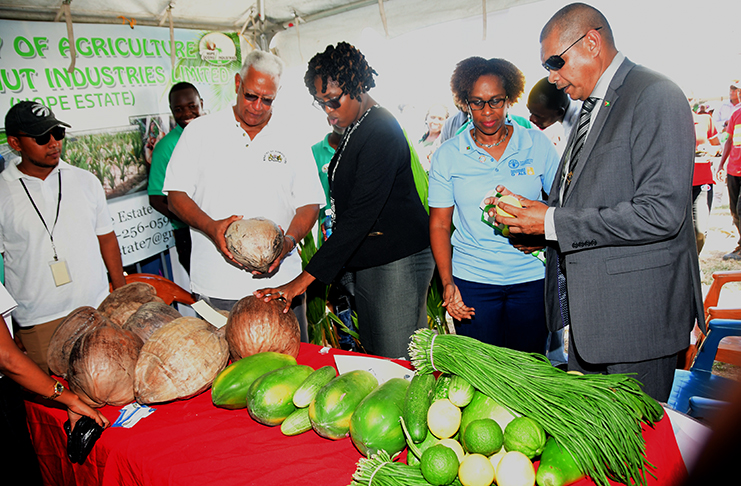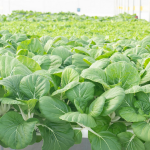
Hon. Minister of Agriculture, Noel Holder (left); Public Service Minister, Tabitha Sarabo-Halley (second from left); Resident FAO Representative, Dr. Gillian Smith and Minister of Business, Haimraj Rajkumar checking out some of the exhibits at the World Food Day exhibition (Guyana Chronicle photo)
Thank you for joining us in celebrating World Food Day. We take the opportunity to join with our international partner, the Food and Agriculture Organization of the United Nations (FAO) to focus on, “Our Actions are our future, Healthy Diets for a #ZeroHungerWorld,” as health problems related to malnutrition is on the rise and to ensure the availability and affordability of healthy diets. We are also observing Agriculture Month under the theme ‘‘Sustainable Agriculture for ensuring Food Safety and a Green Economy.”
Today, on World Food Day, we reinforce our commitment to ‘Safe food and healthy diets’. Guyana as you know is a food secure country but there are pockets of food insecurity and hunger that we need to address. Additionally, given the significant amount of money spent on health problems related to malnutrition, strategies and policies to ensure the availability and affordability of healthy diets is essential for food and nutrition security of our citizens.
Our Actions are our Future. As Guyana is poised to be an oil producing state in 2020, agriculture will always play a major role in our economy. As a nation we must work to push the agricultural sector towards sustainable food production systems, via agriculture health and food safety.
For healthy diets we must improve food safety. Our government have made food safety a public priority. A paradigm shift in the approach to food safety is required starting from our farms and ending at the dining table.
The Ministry of Agriculture has been pursuing interventions to ensure food security for all, specifically, access to safe food throughout the country, with a view to maintaining a healthy and productive population. With the passing of the Food Safety and Animal Welfare Bills, the activation of such practices within Guyana will ensure that the country is a benefactor in securing external markets for its agricultural products, and safeguarding our own food supply.
Ladies and gentlemen, the Food Safety Bill in its entirety would assist in the prevention of food borne diseases through the control of the production, preparation, handling, storage and transportation of food and traceability. It would also coordinate and regulate the fragmented system for food safety in Guyana, alleviate the high levels of diarrhea diseases in children under five, and promote more market opportunities for producers.
As we transition to an oil producing nation, we need to tap in to the market opportunities. However, this cannot be achieved without having quality infrastructure such as the laboratory that would test and certify for the disease, chemical residue, water quality, and general quality, safe and wholesome products intended for export. Additionally, for increase productivity laboratories are needed for soil testing, bio technology, tissue culture, plant breeding and so on.
Laboratories are the backbone of the inspection and certification activity to meet these international standards. Location here in the Agriculture Complex there are the Soil Laboratory and the Bi-Control Laboratory.
The Soil Laboratory main function is soil fertility management, that is, to track the flow of nutrients in the soil for optimum nutrient levels in crop production. Soil test reports will generally provide appropriate fertilizer application recommendations for nitrogen, phosphorous, potassium and limestone. For instance, too little fertilizer will result in low crop yields, while too much fertilizer will waste time, money and risk environmental damage. Therefore, soil testing provides a farmer with a tool that he/she can employ for potential benefit to increased yields, reduced operating costs and greater care of the environment. Additional benefits include; improved crop maturity and quality, higher tolerance to disease and pest damage, and increased growth. The laboratory provides a wide range of testing parameters for soils, plants, water, sugar and other agricultural materials. This lab will now be open to serve the entire agriculture sector.
The next laboratory is the Bio-control Lab. The main objective of national bio-control laboratory is to develop systems to control pests through the use of natural predators instead of using chemical pesticides. This fits in with our sustainable agriculture practices for a green economy. Integrated Pest Management (IPM) reduces the cost of plant protection and environmental pollution caused by application of poisonous pesticides is reduced significantly or eliminated.
This laboratory will be responsible for coordinating research into the plant protection needs for various agricultural crops and propagation of bio-control agents. It will promote integrated pest management for main crops grown in Guyana such as sugar, rice, coconuts and fruits and vegetables..
In recent years, the frequency and intensity of outbreaks of paddy bug, has left rice farmers lamenting for solutions, the Guyana Rice Development Board (GRDB), aware of the damaging and costly effects of paddy bug to the industry, has been giving priority to integrated pest management. Apart from chemical responses, emphasis will be placed on developing effective mechanisms to economically manage the pest, including the utilisation of natural resources like botanicals and biological control agents. Ultimately, there should be reduced dependence on the use of chemical insecticides, coinciding with a sound integrated pest management program.
The Guyana Sugar Corporation has been using various methods of bio-control and an integrated pest management program for many years. It is most noteworthy, that GuySuCo does not use any insecticides in its cultivations and this has been true for the last 20 years The sugar industry has a robust Biological control programme, which a wasp (Cotesia Flavipes) is used to control sugar borers, these are reared in GuySuCo central and estate facilities and released to the cane fields to control stem borers.
With the tremendous experience in having a most successful biological control systems, the Guysuco Plant Protection programme with support from Plant Protection researchers of NAREI and the GRDB will coordinate the National bio-control laboratory that is located at here in the Agriculture Complex. The immediate priorities will include looking at funguses to assist in the control of Paddy Bug. This combined with predatory beetles, aggressive parasites, and disease organisms that confine their activity to agricultural pests would be enlisted and tested for their ability to control these pests such as Paddy bug and Red Palm Mite.
With the bio-control laboratory, the use of natural predators instead of using chemical pesticides will be encouraged, the Integrated Pest Management will not only be cost effective, but encourage bio-diversity within our fields and benefit the environment by relying less on the use of chemicals and therefore benefiting our environment and long-term health of the nation.
On October 23 and 24 we will be commissioning the Hydroment’s Water Quality Laboratory and the Pesticides Toxic and Chemical Control Board (PTCCB) Laboratory respectively. The latter will be examining pesticides residues for ensuring food safety through monitoring the use, patterns and practices of chemicals. While the Water Quality Laboratory will perform chemical, biological and physical testing of water samples from ground or surface water. This is in keeping with their mandate (as outlined in the Water & Sewerage Act (2002)) to monitoring and evaluating the weather and water resources in Guyana and to actively support the government in disaster risk management.
Other notable laboratories in the sector include the GLDA Veterinary Diagnostic Laboratory, NAREI Bi-Control Laboratory and Tissue Culture Laboratory, and GRDB Labs which include
Ladies and gentlemen, you are all aware of the ‘Agriculture Road’ institutions of the Ministry of Agriculture, just to mention them here, they include Guyana School of Agriculture (GSA), National Agricultural Research and Extension Institute (NAREI), the Pesticides and Toxic Chemical Control Board (PTCCB), the Guyana Livestock Development Authority and the Fisheries Department, Satydeow Sawh Aquaculture Station (SSAS). Their close proximity makes a collaborative environment.
Therefore, in the same thrust for inter-agency collaboration and more comfortable office environment the Ministry of Agriculture have made a policy decision to relocate a number of agriculture agencies to Agricultural Complex, La Bonne Intention (LBI) previously known as, GuySuCo’s Head Office Compound, L.B.I.
As you know the Guyana Sugar Corporation office is here, the National Drainage and Irrigation Authority (NDIA) was re-located here in 2018, on October 18, the Guyana Rice Development Board (GRDB) will be commissioning their new office. This will be followed by the Guyana Marketing Corporation (GMC), the Food Safety Authority (FSA) and the United Nations Food and Agriculture Organization (FAO). As all current office space are highly inadequate for the needs of the staff.
And in the future, GuySuCo Soil and Bio-Safety Laboratory will transition in the National (Agriculture) Soils Testing Laboratory and Bio-Safety Laboratory at the Agriculture Complex, L.B.I serving the agriculture sector and not only the sugar industry.
With these measures there will be ample opportunities for coordination, collaboration and comradery on issues of drainage and irrigation, sugar and rice industry and agriculture development in one compound. Furthermore, with Mon Repos only a stone throw away this with further be enhance with the other agriculture offices located there
I wish to implore all officers of the Ministry of Agriculture to ensure you take advantage of your colleagues being in such close vicinity, to cherish this new Agriculture Complex and to ensure our stakeholders are served with value driven services.
The significance of the agriculture sector to Guyana’s economy and the sustainable livelihood cannot be overemphasize. Agriculture contributes 16.2% to the national GDP, the relative share of persons employed in agriculture is 17.8%, and approximately 26% of Guyana’s export earning come from agriculture.
It is a sector that is crucial in terms of reducing unemployment, poverty alleviation and for bolstering economic development. Significantly, sustainable food security is a goal that the sector aims to achieve by improving the quality and quantity of the crops, livestock and fisheries sub-sectors.
The Ministry of Agriculture policies to develop the sector have focus on 4 main areas:
- Climate mitigation to increase the number of pumps and pump stations, kokers, canals and sluices to increase our ability to remove excessive water from the land.
- Hinterland Development for climate adaptation
- Coastland Expansion via increase land and productivity under agriculture in each region
- Market-led production focusing on Import Reduction and Export Promotion of Agriculture Commodities
Guyana has a land area of 83,000 square miles but with almost 90% of its population occupying a strip of land approximately 200 miles long and 30 miles in width, and having 75% of the main economic activities concentrated on this low-lying coastal zone situated some 6 feet below sea level.
Climate change have begun to disastrously impact the economic viability of the agriculture sector. Specifically, the inundation of valuable agricultural land due to climate change over the last month. We have seen tidal water levels much higher above the normal level causing the overtopping and in some cases breach in the sea defence. Affecting agricultural communities (cash crops, livestock and rice) of Region 2, 3, 4, 5 and 6 with flooding due to the high tides.
To reduce the exposure and vulnerability of our agriculture and citizens to climate-related extreme events and other shocks and disasters. We have devised two distinct ways – through mitigation of its effects, or long term adaptation to minimize its effects while ensuring continued agricultural development.
With mitigation, our goal is to provide resilient infrastructure to prevent economic losses due to climate change and other effects. We continue to manage, improve, extend and provide drainage, irrigation and flood control infrastructure and services across the country through the National Drainage and Irrigation Authority (NDIA).
NDIA has been working to raise the drainage coefficient or capacity from the insufficient 1.5 inches of rainfall in 24 hours drainage to at least 3.5 inches in 24 hours by __. The effort require to do this is enormous, the NDIA currently directly oversees the operation of 20 pump stations with 63 drainage pumps, with an additional x planned for the remained of 2019. The NDIA also oversees the Coastal D&I system that include about 500 km of main irrigation canals, 1,100 km of secondary canals, 500 km of main drainage channels, and 1,500 km of secondary drainage channels supported by kokers and sluices. These assist to increase our ability to remove excessive water from the land. NDIA currently holds the largest budget allocation in the MOA at 52%, this, is because the higher the drainage coefficient the greater the capital investment required. Furthermore, NDIA has started to complement its engineers with state of the art machinery to efficiently complete the works required such as Cutter Suction Dredge, amphibious excavator.
The mandate of NDIA has been boosted by the Flood Risk Management Project (FRMP) which constructing pump stations at Lusignan, Buxton and Hope/Enmore; the Cunha Canal Rehabilitation Project (CCRP), and the Rural Agriculture Infrastructure Development Project (RAID) that is operating in Mocha, Ithaca, BV/Triumph and Buxton.
It also important we boost capacity for better irrigation and water management in the agricultural industry, thereby enhancing the competitiveness of the various sectors and improving productivity.
Since 2017, NDIA and RAID project has make available 17,655 acreage of lands for agriculture. With more demand for new land from rice cultivation for up to 6,114 ha in 2020 onwards.
Adaptation in the Guyana context involve extending our agricultural activities inland to higher ground. Being a signatory to the Paris 21 Agreement, which discourages the clearing of our 87% forested land for agricultural purposes, we have been concentrating our agriculture expansion on two distinct areas of savannah land, the Intermediate Savannahs of Region 10 (approximately 292,000 ha), and the South East Rupununi Savannahs of Region 9 (some 1.3 million ha).
Moreso, to ensure the realisation of the area’s agricultural potential, the vision is to have agricultural stations constructed in the major eco-zones in the country. This would include orchards, nurseries and seed production, breeding herds of cattle and small ruminants to provide breeding stock for farmers and seed stock for entrepreneurs. The Ministry of Agriculture have commence with the development of the $220 million Region 10 Ebini Agricultural Research Facilities focusing on Research Programs in cassava, peanuts, orchards, and livestock (cattle and small ruminants). The next major station will be in Pirara in Region 9 focusing on cattle, rice, orchard crops and cassava.
Since 2018 the sugar industry’s production has been from three operating factories Albion, Blairmont and Uitvlugt. Even though the industry is faced with declining sugar revenues, higher costs and the need to produce more value added sugar products. It is still an important sector that supports approximately 8,000 employees and their families,
50 private cane farmers and about 250 local businesses, contractors, utilities for its operations. As we celebrate World Food Day, I want to emphasize the government commitment to the sugar industry and to support the strategies to enhance profitability of the industry. Some of these include:
- Produce 150,000 tonnes sugar with emphasis on value added sugars.
- Expansion of Private Farmers at Uitvlugt from 1,402 ha (2018) to 3,600 ha in 2022 and beyond.
- Commence production of Plantation White Sugar at Albion by 2021. Targeting 30% of the CARICOM Region, which has a current market size of 190,000 tonnes.
- Co-generation Plants at Albion to reduce the dependency on fossil fuel and maximize the use of bagasse. And sell excess power generated will also be exported/sold to the National Grid.
- Expansion of Blairmont cultivation to include Ellis Lands
Ladies and gentlemen, Guyana is self- sufficient in livestock products, with the exception of milk and other dairy products. Thus, the Guyana Livestock Authority efforts have been concentrated on supporting dairy development to reduce the G$7.8 Billion of imported milk and milk products.
Food safety and the production of safe and wholesome food is a priority, therefore the establishment of the certified abattoir and the establishment of a swine processing facility. These would not only position us to be an exporter of meat, but to meet the food health standards that are requisite for the supply of beef and pork to the hospitality and some other sectors in Guyana. Simultaneously they have been efforts to develop the local herd of cattle and swine through the genetics improvement programme. From 2017 to HY 2019 2,720 Artificial Inseminated (AI) offsprings of cattle and swine have been registered with GLDA.
In 2017, GLDA launched the Black Giant Chicken Project. The initiative aimed to improve the nutritive base of hinterland residents, through the increased production of both meat and eggs. Ladies and gentlemen, I am happy to report this was a huge success. We have thus far _dormitory schools in Regions __ with the Black Giant Chicken and over 20,000 distributed to communities and schools. This programme is also a success for the Coastland (Regions 2, 3,4,5,6 & 10) with approximately 12,000 chicks sold to over 200 poultry farmers. In 2019, GLDA is expected to produce as much as 24,000 chicks to satisfy the demand of the coastal poultry farmers.
To facilitate the movement of cattle and resources along the Berbice River and in the Intermediate Savannahs, GLDA acquired a G$30M cattle barge in 2017. This will promote faster development to the Intermediate Savannah (IS) and ensure good animal welfare practices when movement of cattle to and from the IS. The introduction of apiculture to the hinterland regions is another initiative of the GLDA.
National Agricultural Research and Extension Institute (NAREI) role is: increasing crop production and productivity via research; transferring appropriate technology (inclusive of climate smart practices) to farmer via extension; safeguard our crop agriculture against the entry, establishment, and spread of plant pests and deadly weeds via the plant protection and quarantine service; and restoration of coastal mangrove ecosystem.
NAREI is the agency to ensure an abundant, high-quality, and varied food supply, that is utilizing sustainable/green agricultural practices for local consumption, our ago-processed sector, animal feed industry and for international trade. And at the same time, reducing the food imported of onion, tumeric, ginger and potato etc.
One of the main areas of focus in the third largest crop in Guyana, that is, coconut. The government has been actively pursuing the revitalization of the coconut industry through NAREI and the Hope Coconut estate. Both agencies have been ensuring coconut production is maximized through improved agronomic practices as well as for the supply of planting material. The Hope Estate has seedling production of about 100,000 nut per annum.
The Department has concentrated on its monitoring and surveillance programme to prohibit overfishing, destructive fish practices and illegal unreported and unregulated (IUU) fishing. In 2016 Guyana became the 25th State to ratify the Port State Measure Agreement (PSMA) with the FAO and we are committed to the cause.
Over the last 10 years, the strong public-private partnership between the Ministry of Agriculture, Fisheries Department and the Guyana Association of Trawler Owners and Seafood Processors (GATOSP) has resulted in the achievement of Marine Stewardship Council Certification in August 2019. This is a significant milestone for the industry as it states we are engaging in sustainable seabob fishery. Our quest is to maintain this certification and add more fishery to such standards.
In terms of Aquaculture, we continue to promote this industry with the sale of fingerlings at the Region 2 Aquaculture Station and the Mon Repos based Aquaculture Station. The current focus is to develop the Aquaculture Regulation and promote local feed production for aquaculture via research.
The Guyana Marketing Corporation concentrates on Agriculture Business Development, creating linkages between farmers and agro-processors and prospective buyers. The work programme is heavily focus on capacity building and training in areas such as Marketing, Agriculture Business Development, labeling and packaging, Cost of production analysis, post-Harvest Management, among others. In fact, for the years 2017 to Jan-June 2019, GMC has trained 1,628 farmers and _agro-processors.
Some noteable achievements of GMC, support to agro-processors in access loans and grants, generation of more than 200 nutritional facts for agro-processed productsusing the ESHA nutritional facts software since 2015; establishment of Guyana Shop corners in _ supermarkets, participation in x local and x international trade shows. Please how your support to GMC on October 26, 2019 at the Market day, Durban Park.
The Ministry of Agriculture will continue to strengthen the agriculture education programme at the Guyana School of Agriculture. During 2015-2019, this institution produced 627 students (in diploma & certificate), to support the development of the agricultural sector. In addition, there is a focus on agro-processing with the Mon Repo Laboratory and new Agro-Processing Facility to be established at the GSA Essequibo Campus.
Lastly, the event today, we have a lot in store for you, we have approximately 40 booths, comprising all the agricultural agencies, IICA, FAO, Carnegie, University of Guyana, farmers, agro-processors and many other stakeholders of the Ministry of Agriculture. There is also a food court and a salad booth.
In conclusion, I wish to re-emphasize the importance our Government is placing on the development of agriculture and ensuring healthy consumption of our citizenry. Ladies and gentlemen, as we are involved in “Sustainable Agriculture for ensuring Food Safety and a Green Economy” we recommit our actions for a Zero Hunger world by 2030.
Thank you





